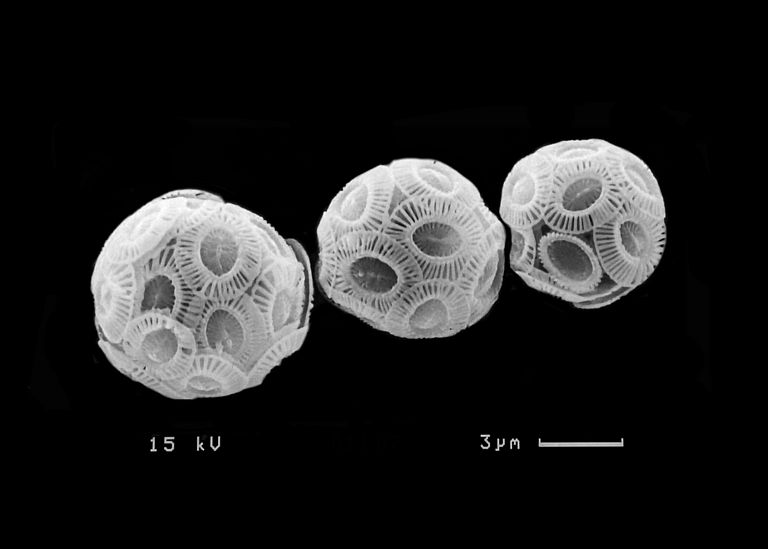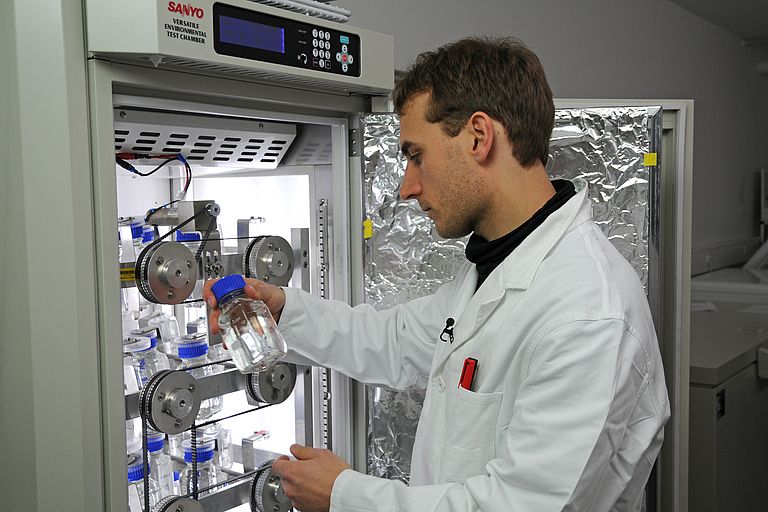Small algae with great potential
Unique laboratory experiment shows rapid evolutionary adaptation to ocean acidification and warming
In an unprecedented evolution experiment scientists from GEOMAR Helmholtz Centre for Ocean Research Kiel and the Thünen Institute of Sea Fisheries have demonstrated for the first time, that the single most important calcifying algae of the world’s oceans, Emiliania huxleyi, can adapt simultaneously to ocean acidification and rising water temperatures. In their study, the researchers found no evidence for the widespread idea that evolutionary adaptations to these two aspects of climate change would interfere with each other.
“Even though the experiment was conducted under laboratory conditions, it clearly shows the high potential for evolutionary adaptation in an oceanic microbe such as Emiliania huxleyi”, Lothar Schlüter, first author and PhD student at GEOMAR, points out. “Now that evidence has been provided, predictions about the future ocean definitely have to take such adaptive changes into account.” The study was funded by the Kiel Cluster of Excellence “The Future Ocean” and the German research network BIOACID (Biological Impacts of Ocean Acidification). The results will be presented in the October issue of the journal Nature Climate Change.
The study was initiated by isolating a single cell of Emiliania huxleyi from the Raunefjord in Norway. Since the algae reproduces by cell division about once per day in the laboratory, numerous genetically identical cultures could be derived from the isolate. Five cultures each were kept under control conditions (15°C) and at elevated water temperature (26°C) in combination with three different concentrations of carbon dioxide (CO2): a control value with today's conditions, the conditions of the Intergovernmental Panel on Climate Change’s “worst case scenario” and the highest possible degree of acidification.
After one year – corresponding to about 460 algae generations – the scientists tested how the adapted and the control populations reacted to the high temperature within five-day intervals: The adapted populations grew significantly faster than the non-adapted at 26 degrees – regardless of the carbon dioxide level. The adapted cultures produced even more new biomass and about twice as many calcite platelets than the control group under the high temperatures.
In one part of their experiment, the researchers came to the surprising conclusion that the cultures that had been exposed to the highest CO2 value and the highest temperatures at the same time for one year adapted fastest to the newly higher temperatures. “Over several hundred generations, apparently those new mutations that are advantageous in conditions of both ocean acidification and warming emerged and swept through the population”, concludes Schlüter.
Unicellular calcifying algae such as Emiliania huxleyi play an important role in the transport of carbon to the deep ocean. Therefore, the researchers analysed the ratio of the inorganic calcite platelets to the organic carbon inside the cells after the adaptation phase. It was nearly the same as that of the control population under current ocean conditions. “This means that the evolutionarily adapted algae display the same specific weight as the original, isolated cultures under present-day conditions. Oceanographers call this the ballast effect – the transport of carbon into the ocean interior via sinking dead cells or fecal pellets where it is stored for a very long time”, explains Prof. Dr. Thorsten Reusch, head of Evolutionary Ecology at GEOMAR. “The function of the ocean as a carbon sink, which mitigates the effects of climate change, will thus be effectively maintained.”
In 2012, evolutionary ecologists at GEOMAR showed for the first time that Emiliania huxleyi is able to adapt to ocean acidification by means of evolution. Since then, the laboratory experiments were continued and refined. “Now the world's longest and most complex experiment on this issue is running in our laboratories", says Thorsten Reusch. The lab results are now being integrated into biogeochemical models, which calculate the productivity of the ocean of the future and the limits of carbon storage. In addition, the findings on the evolutionary adaptation are being incorporated into an investigation of future phytoplankton species shifts.
Original publication:
Schlüter, L.; Lohbeck, K. T.; Gutowska, M, A., Gröger, J. P.; Riebesell, U.; Reusch, T. B. H. (2014): Adaptation of a globally important coccolithophore to ocean warming and acidification, Nature Climate Change, doi: 10.1038/nclimate2379
“The Future Ocean” in brief:
The Kiel Cluster of Excellence "The Future Ocean" aims to increase our understanding of ocean change and its associated potentials and risks in order to enter into a new symbiotic relationship between humans and the sea. In "The Future Ocean", experts from diverse specialist areas are combining their expertise: For example, lawyers and geoscientists are investigating questions on how and who has the right to exploit resources on the seafloor. Climatologists and economists are working on the question of what conditions make CO2 storage on the seafloor a relevant option. Marine scientists, medical researchers, mathematicians, chemists, engineers and social scientists are dedicating themselves to further questions. The network partners include six faculties and 26 institutes at Kiel University, as well as the GEOMAR Helmholtz Centre for Ocean Research Kiel, the Kiel Institute for the World Economy (IfW) and the Muthesius Academy of Fine Arts and Design. The Cluster of Excellence “The Future Ocean” is supported within the framework of the “excellence initiative” of the German Research Foundation (DFG) on behalf of the German government and the federal states of Germany. More information at www.futureocean.org.
BIOACID in brief:
Under the umbrella of BIOACID (Biological Impacts of Ocean Acidification), 14 institutions examine how marine ecosystems react to ocean acidification, how this affects the food web and the exchange of material and energy in the ocean and how the changes influence the socio-economic sector. The project started in 2009 and entered its second three-year funding period in September 2012. The Federal Ministry of Education and Research (BMBF) supports the current work with 8.77 million Euros. The work is coordinated by GEOMAR Helmholtz Centre for Ocean Research Kiel. A list of member institutions, information on the scientific programme and the BIOACID committees as well as facts about ocean acidification can be found on the website www.bioacid.de.
Contact:
Maike Nicolai (Communication & Media), Phone: +49-431 600 2807, mnicolai(at)geomar.de







